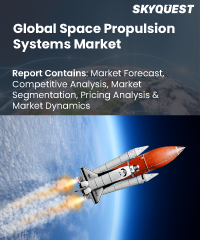
Report ID: SQMIG20A2146

Report ID:
SQMIG20A2146 |
Region:
Global |
Published Date: September, 2024
Pages:
202
|
Tables:
90 |
Figures:
76
Space Propulsion Systems Market size was valued at USD 7.4 Billion in 2023 and is poised to grow from USD 8.97 Billion in 2024 to USD 41.69 Billion by 2032, growing at a CAGR of 21.2% during the forecast period (2025-2032).
The Global Space Propulsion Systems Market is an exciting and rapidly evolving industry that plays a crucial role in the exploration and utilization of outer space. This market revolves around the development and deployment of propulsion systems that enable spacecraft to maneuver, navigate, and propel themselves in space. The purpose of the Space Propulsion Systems market is to provide the necessary propulsion technologies to support space missions, satellite deployments, deep space exploration, and other space-based activities. These systems are essential for achieving various objectives, including satellite positioning and orbit control, spacecraft propulsion, trajectory corrections, and interplanetary travel. Several drivers contribute to the growth of the Space Propulsion Systems market. Firstly, the increasing demand for satellite-based services, such as telecommunication, broadcasting, weather forecasting, and navigation, drives the need for advanced propulsion systems to ensure accurate positioning, orbital maintenance, and prolonged satellite lifespan. Additionally, the growing interest in space exploration and the emergence of commercial space travel create opportunities for the development of innovative propulsion technologies. Moreover, advancements in propulsion systems, such as electric propulsion, ion thrusters, and solar sails, offer improved fuel efficiency, longer operational lifetimes, and enhanced mission capabilities. These technological advancements fuel market growth and attract investments in research and development.
However, the Space Propulsion Systems market does face certain restraints. The high costs associated with research, development, and manufacturing of space propulsion technologies pose a challenge to market expansion. Regulatory and legal frameworks related to space activities also impact market dynamics, requiring compliance with international space treaties and government regulations. Key trends in the Space Propulsion Systems market include the development of green propulsion technologies to reduce reliance on hazardous propellants, the miniaturization of propulsion systems for small satellites, and the integration of advanced materials and manufacturing techniques to enhance efficiency and performance. Amidst the challenges and trends, the Space Propulsion Systems market offers significant opportunities. The increasing demand for satellite services, the rise of commercial space activities, and the exploration of deep space provide a fertile ground for innovation and market growth. Furthermore, collaborations between government agencies, private companies, and academic institutions contribute to technological advancements and create avenues for market expansion.
US Space Propulsion Systems Market is poised to grow at sustainable CAGR for the next forecast year.
Our industry expert will work with you to provide you with customized data in a short amount of time.
REQUEST FREE CUSTOMIZATIONWant to customize this report? This report can be personalized according to your needs. Our analysts and industry experts will work directly with you to understand your requirements and provide you with customized data in a short amount of time. We offer $1000 worth of FREE customization at the time of purchase.

Report ID: SQMIG20A2146